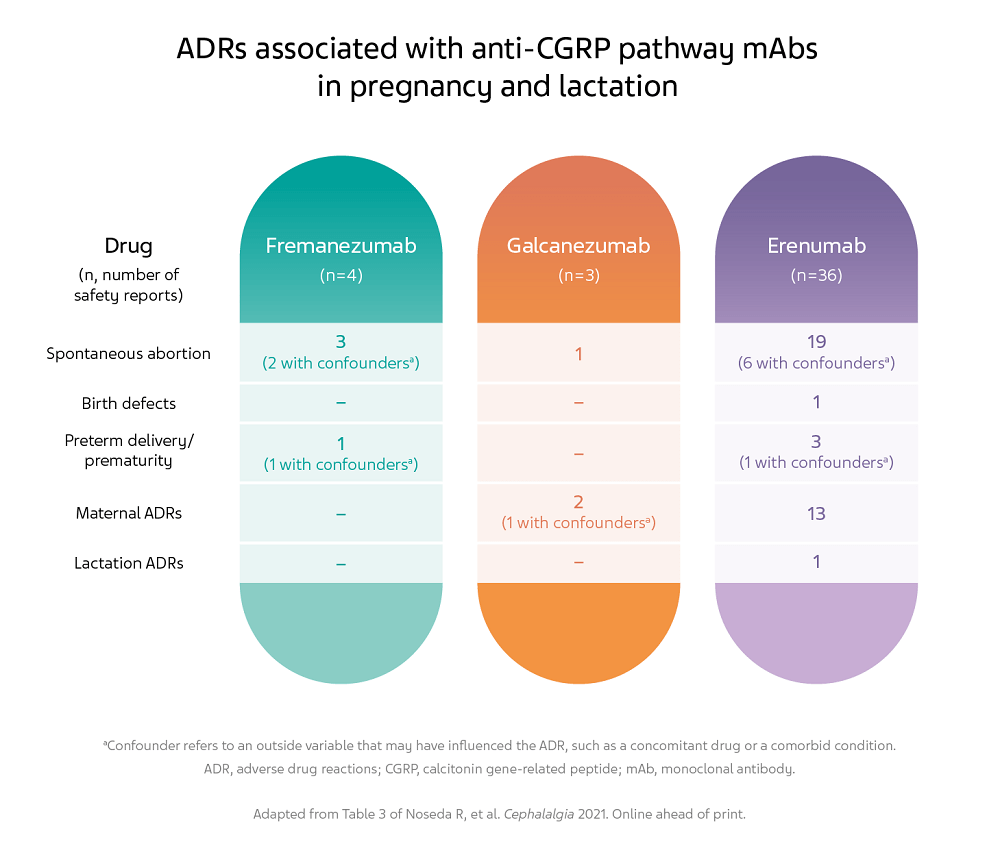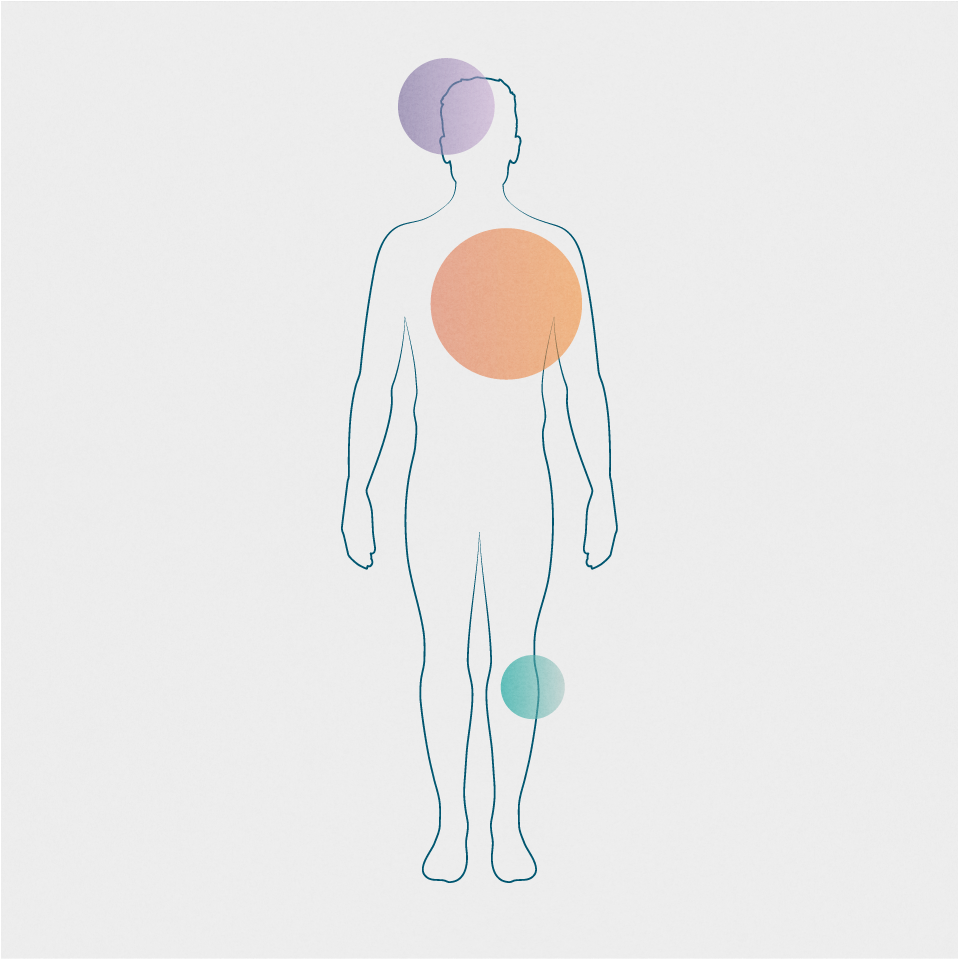
PUBLICATION PULSE: Assessing the safety of anti-CGRP pathway mAbs in pregnancy and lactation
Noseda R, Bedussi F, Gobbi C, Zeca C, Ceschi A. Safety profile of erenumab, galcanezumab and fremanezumab in pregnancy and lactation: Analysis of the WHO pharmacovigilance database. Cephalalgia 2021. Online ahead of print.
The lead-up
Due to calcitonin gene-related peptide’s (CGRP) role in migraine pathogenesis, CGRP and its receptor have become targets for the development of migraine treatments.1,2 Fremanezumab, galcanezumab and erenumab are monoclonal antibodies (mAb) targeting CGRP or its receptor.3-5 These mAbs are approved for the prevention of chronic and episodic migraine, and have quarterly or monthly dosing regimens due to their long half lives.3-5 While a long half-life affords the convenience of infrequent injections, it could also result in foetal exposure in women who become pregnant while taking these drugs.6 Unplanned pregnancies, which account for approximately 49% of all pregnancies, are a complication that must be considered for women of childbearing age taking these drugs.6 Though there are benefits for women with migraine that become pregnant—migraine often improves or stops completely during pregnancy—the safety of the fetus must also be considered.7 This recent pharmacovigilance study assessed the safety profile of fremanezumab, galcanezumab and erenumab in pregnancy and lactation.

The approach
To perform the safety analysis, Noseda et al. used VigiBase, the World Health Organization’s (WHO) global database of adverse drug reactions (ADR). The authors selected safety reports reporting ADRs classified under “pregnancy and neonatal topics” associated with fremanezumab, galcanezumab and erenumab. From this group of reports, they extracted the final dataset, which comprised reports for which they determined there was a correlation between exposure to one of the anti-CGRP pathway mAbs and a pregnancy- or lactation-related adverse event. They also performed a disproportionality analysis, which compared the proportion of specific ADRs reported for the anti-CGRP pathway mAbs against the proportion of the same ADRs from a control group of drugs.

The findings
Over 21 million safety reports were gathered from Vigibase, and 94 were selected that were associated with fremanezumab (n=13), galcanezumab (n=31), or erenumab (n=50) concerning pregnancy and lactation. In these reports, drug exposure mostly occurred during pregnancy (90.4% of reports), with the rest occurring prior to pregnancy (5.3%), during lactation (1.1%), via paternal exposure (1.1%) or the time of exposure was unknown (2.1%). The safety reports reported either solely drug exposure (54.3%) or mentioned one or more ADRs (45.7%). In total, 47 ADRs were reported, which affected the mother and/or the fetus.
There were 15 safety reports (16.0%) reporting 18 maternal ADRs, including ineffective migraine treatment, nausea/vomiting, hypothyroidism and depression, among other reactions. Two reports (2.1%) reported birth defects. Three (3.2%) reported preterm birth and prematurity associated with erenumab. Spontaneous abortion was one of the most common ADRs, occurring in 23 reports (24.5%), of which 15 (16.0%) were without confounders. In the disproportionality analysis, the authors did not find disproportionality for spontaneous abortion with fremanezumab, galcanezumab or erenumab. Similar results were found when excluding confounders.

Figure 1. ADRs from the safety reports collected in the analysis, organized by type of ADR and association with fremanezumab, galcanezumab or erenumab.

The scrutiny
This study found that, in the 1.5 years since erenumab was first approved by the US Food and Drug Association (FDA), no specific maternal toxicities, patterns of major birth defects or spontaneous abortion have emerged as hallmarks of toxicity with fremanezumab, galcanezumab or erenumab. Ethical restrictions prevented the inclusion of pregnant women in randomized clinical trials. As such, the majority of information on drug safety of anti-CGRP pathway mAbs is derived from observational studies and relies on experts’ opinions. Most of the safety reports included in the study were from the United States because of the initial approval of the mAbs by the FDA. Another limitation is the presence of comorbidities and concomitant drugs, which could cast doubt on the relationships of ADRs with specific drugs. The drugs also have different mechanisms and therefore might not share the same safety profile during pregnancy and lactation; each mAb should be individually investigated more thoroughly in this regard.

The next questions
- Will long-term safety data corroborate the findings of this study?
- Does the specific mechanism of each mAb affect its safety profile in pregnancy and lactation?
- Will a larger sample size of safety reports produce similar results to this study?

The bottom line
In this pharmacovigilance study of 94 safety reports from a WHO database, fremanezumab, galcanezumab and erenumab were not found to have any specific maternal toxicities, patterns of major birth defects or spontaneous abortion. A disproportionality analysis of spontaneous abortions found that the anti-CGRP pathway mAbs did not have a higher proportion of that specific ADR against all other drugs. Because knowledge of this safety profile is based on a small sample size and limited long-term safety data, pregnant and lactating migraine patients taking these drugs should be closely monitored.
Tringali G, Navarra P. Anti-CGRP and anti-CGRP receptor monoclonal antibodies as antimigraine agents. Potential differences in safety profile postulated on a pathophysiological basis. Peptides 2019;116:16–21.
Edvinsson L. Calcitonin Gene–Related Peptide (CGRP) and the Pathophysiology of Headache. CNS Drugs 2001;15:745–53.
AIMOVIG® (erenumab-aooe). Summary of Product Characteristics. Novartis Pharmaceutical Corporation. Updated April 2020.
EMGALITY® (galcanezumab-gnlm). Summary of Product Characteristics. Eli Lilly and Company. Updated December 2019.
AJOVY® (fremanezumab-vfrm). Summary of Product Characteristics. Teva Pharmaceutical Industries. Updated January 2020.
Dodick DW. CGRP ligand and receptor monoclonal antibodies for migraine prevention: Evidence review and clinical implications. Cephalalgia 2019;39:445–58.
Granella F, Sances G, Pucci E, Nappi RE, Ghiotto N, Nappi G. Migraine with aura and reproductive life events: a case control study. Cephalalgia 2000;20:701–7.



